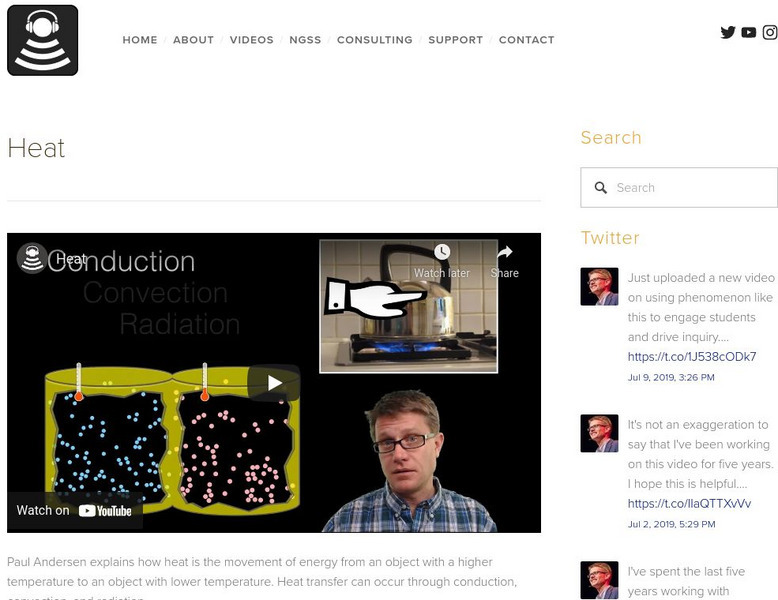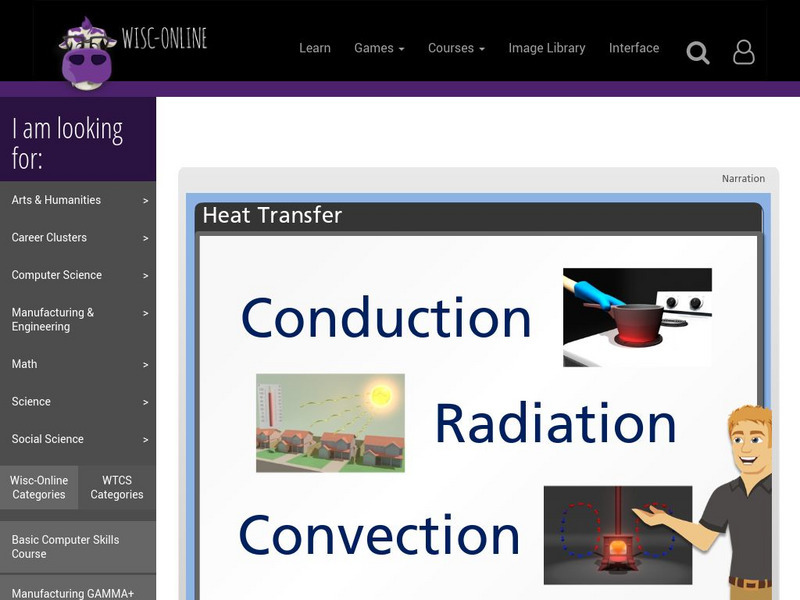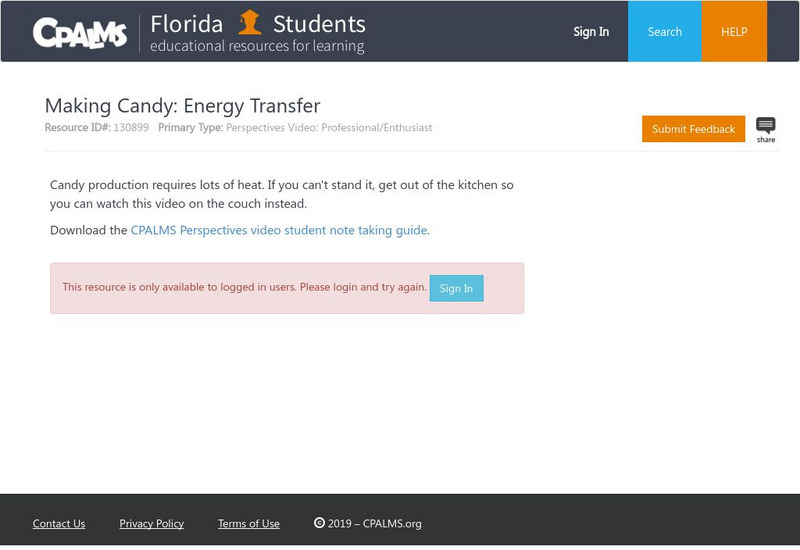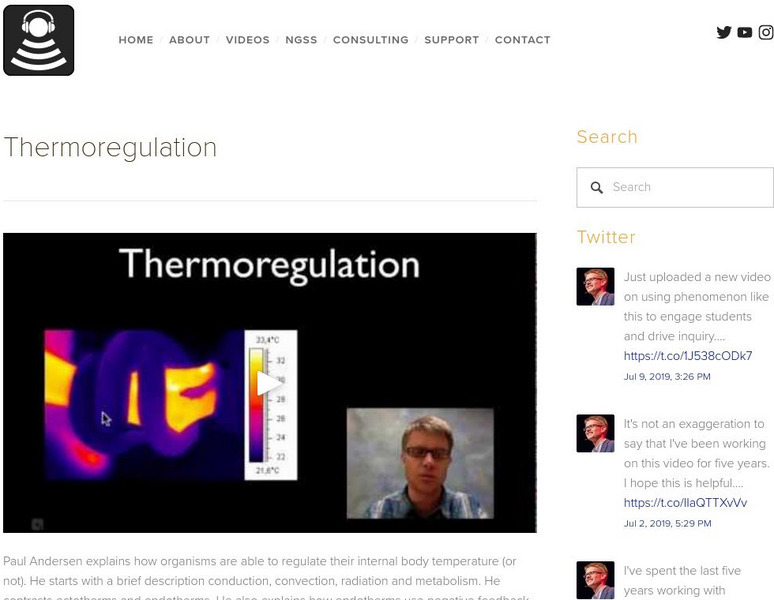Hi, what do you want to do?
Crash Course
The Physics of Heat: Crash Course Physics #22
Compare and contrast the physics of heat flow with a well-designed video lesson. The 22nd installment of the Crash Course series is an overview of the physics of heat. After beginning with a discussion of thermal energy and heat, the...
Teacher's Pet
Convection
Does it make more sense to place a space heater in the middle or on one side of a room to heat it? After watching a video on convection that explains what causes it, and how it works, pupils know the correct answer.
Crash Course
The Sun
Our future literally depends on the sun. The video introduces the sun as a star. It explains the plasma magnetic fields, sunspots, solar flares, coronal mass ejections, and more. It concludes with how we rely on the sun, how we protect...
DoodleScience
Heat Transfer - Conduction and Convection
Use science to explain why sitting on a metal bench on a cold day isn't a good idea. The instructor describes conduction and convection through drawings and animations. Learners understand how conduction and convection transfer heat...
Curated OER
Denver's Brown Cloud
Why does a brown cloud occur in Denver at a certain time of the year? When warm air is higher in the atmosphere, it traps cooler, denser air below and smog just sits in between them. Using bottles of colored hot and cold water, this...
Steve Spangler Science
Colorful Convection Currents - Sick Science! #075
Use this demonstration to help your class understand convection currents. Learners put food coloring in bottles, one with hot and the other cold water, and see what happens. This is a terrific way to make this idea come alive. Once they...
Steve Spangler Science
Flying Tea Rocket - Sick Science! #024
Add this to your repertoire of convection demonstrations. This one can be done by mature and skilled laboratory classes. Basically, open a tea bag, clip the ends off, open and empty it, then stand it on one end. Light the top of it. As...
Steve Spangler Science
Denver's Brown Cloud - Cool Science Experiment
Why does a brown cloud occur in Denver at a certain time of the year? When warm air is higher in the atmosphere, it traps cooler, denser air below and smog just sits in between them. Using bottles of colored hot and cold water, this...
Curated OER
Colorful Convection Currents
Use this demonstration to help your class understand convection currents. Learners put food coloring in bottles, one with hot and the other cold water, and see what happens. This is a terrific way to make this idea come alive. Once they...
DoodleScience
Heat and Thermodynamics
Looking for a review that won't take up an entire class period? Here is a video that provides a quick review of heat and thermodynamics. It covers more than nine topics in less than five minutes.
Curated OER
Mid Ocean Ridges, Volcanoes, and the Arctic
Journey underwater for a better look at the tectonic plates and the volcanoes they create. Although this video is slightly dry, it is packed with valuable information and easy-to-understand visual images. Consider using a portion to...
PBS
Pbs Learning Media: Testing Insulators: Ice Cube in a Box
Watch the ZOOM cast discover which insulator -- newspaper or aluminum foil -- is better at keeping an ice cube frozen longer. [4:58]
PBS
Pbs Learning Media: Cooking Cookies With Solar Power
In this video segment adapted from ZOOM, two solar cookers are tested against a control to see which can cook a "s'more" faster. [3:11]
PBS
Pbs Learning Media: Arctic Climate System
Learn how the Arctic is a part of a global climate system in this video segment adapted from the National Film Board of Canada.
Science for Kids
Science Kids: Experiment Videos: Flying Tea Bag Experiment
See how a simple tea bag turns into a rocket with the help of heat convection. [1:24]
Bozeman Science
Bozeman Science: Heating
In the following video Paul Andersen explains how heating is the transfer of energy (heat) from a warmer object to a cooler object. Heat can be transferred through conduction, convection and radiation. At the microscopic level conduction...
Bozeman Science
Bozeman Science: Heat
In the following video Paul Andersen explains how heat is the movement of energy from an object with a higher temperature to an object with lower temperature. Heat transfer can occur through conduction, convection, and radiation. [4:10]
Wisc-Online
Wisc Online: Heat Transfer: Convection, Conduction, Radiation
An interactive lesson illustrating the three methods of heat transfer: convection, conduction, and radiation. See short animations, and read about examples of each method.
Khan Academy
Khan Academy: Computer Model of Mantle Convection
See how scientists study mantle convection, or the flow of hot rock in the Earth's deep interior, in order to better understand how this flow shapes the surface of the Earth. Learn how convection makes the Earth dynamic. [7:10]
Bozeman Science
Bozeman Science: Conservation of Energy and Energy Transfer
Paul Andersen explains how energy is conserved within a system. In both macroscopic and microscopic collisions, the amount of energy before the collision is equal to the amount after. He then defines heat as energy transfer between...
CPALMS
Florida State University Cpalms: Florida Students: Making Candy: Energy Transfer
See how energy transfer is used when making candy. [5:05]
Bozeman Science
Bozeman Science: Thermoregulation
Paul Andersen explains how organisms are able to regulate their internal body temperature (or not). He starts with a brief description conduction, convection, radiation and metabolism. He contrasts ectotherms and endotherms. He also...
























